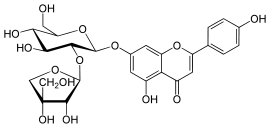Apiin
 | |
| Names | |
|---|---|
| IUPAC name
7-[(2S,3R,4S,5S,6R)-3-[(2S,3R,4R)-3,4-Dihydroxy-4-(hydroxymethyl)oxolan-2-yl]oxy-4,5-dihydroxy-6-(hydroxymethyl)oxan-2-yl]oxy-5-hydroxy-2-(4-hydroxyphenyl)chromen-4-one | |
| Other names
Apioside Apigenin-7-apioglucoside Apigenin-7-O-apioglucoside | |
| Identifiers | |
3D model (JSmol) |
|
| ChEBI | |
| ChEMBL | |
| ChemSpider | |
| ECHA InfoCard | 100.043.421 |
PubChem CID |
|
| |
| |
| Properties | |
| C26H28O14 | |
| Molar mass | 564.50 g·mol−1 |
Except where otherwise noted, data are given for materials in their standard state (at 25 °C [77 °F], 100 kPa). | |
| Infobox references | |
Apiin is a natural flavonoid, a diglycoside of the flavone apigenin found in the winter-hardy plants parsley[1] and celery.[2] The glycoside moity at carbon-7 of apiin, O-β-D-apiofuranosyl(→)2-β-D-glucosyl, is carried by several other flavones in parsley plant and seed.[3] The sugar apiose possibly play a role in winter hardiness of celery, duckweed and parsley.[4]
See also
- Apiose
- Apiitol
- Hamamelose
References
- ↑ H. Meyer; A. Bolarinwa; G. Wolfram; J. Linseisen (2006). "Bioavailability of Apigenin from Apiin-Rich Parsley in Humans". Ann Nutr Metab. 50 (3): 167–172. doi:10.1159/000090736. PMID 16407641.
- ↑ S. R. Gupta. "A study of apiin from the parsley seeds and plant". doi:10.1007/BF03172503. Retrieved 12 October 2014.
- ↑ page 245 "Methods in plant biochemistry" volume 2: "Carbohydrates", ISBN 0080984207
- ↑ page 136 "Advances in Carbohydrate Chemistry and Biochemistry", Volume 31, ISBN 0080562906
This article is issued from
Wikipedia.
The text is licensed under Creative Commons - Attribution - Sharealike.
Additional terms may apply for the media files.